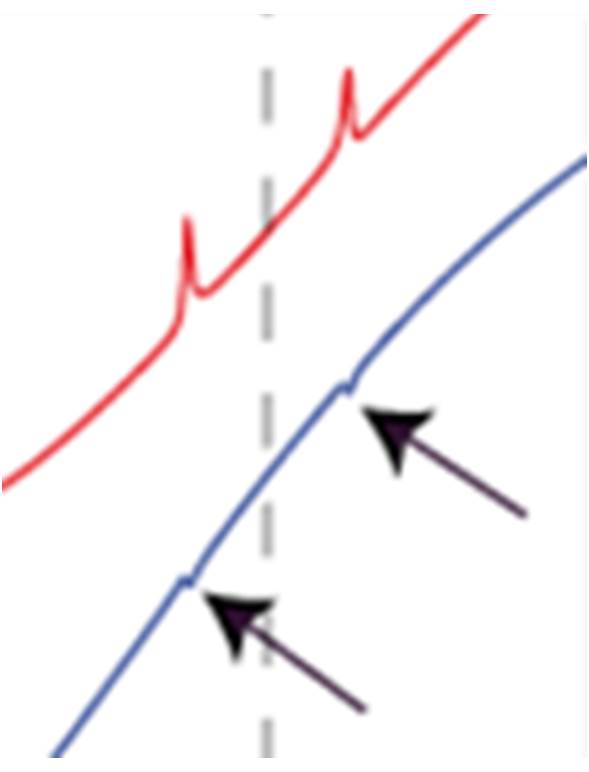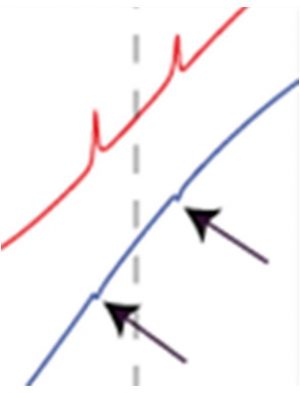Nuclear magnetic resonance (NMR) is a powerful but poorly sensitive analytical technique. Major challenges in chemical analysis (the detection of products in very low concentrations or study of isotopic effects, for instance) encourage to explore new approaches to detect and separate weak signals from the main component ones.
In this framework, one approach was studied: instead of applying a radiofrequency pulse to excite the nuclear magnetization, it is possible to analyze the autocorrelation of the noise of the signal at the output of the radiofrequency NMR detection coil, which is, by construction, strongly coupled to the spins of the sample to be analyzed. As part of a collaborative effort with a team from the Johannes Kepler University in Linz (Austria), supported by a joint ANR-FWF grant, a new general theory of this type of detection has been established, showing the large improvement in sensitivity allowed by the nuclear spin-noise technique.
Moreover, a spectral signature due to the inhomogeneity of the high static magnetic field is revealed. Being unaffected by the nonlinear coupling between the magnetization of the sample and the detection coil, it provides an absolute reference for the measured chemical shifts. This improved detection capability could be applied to the measurements of secondary isotopic effects [1].

In the usual procedure for an NMR measurement, the nuclear spins of the material to be studied are polarized by means of a (generally) high static magnetic field (few Tesla) and the resulting nuclear magnetization is further excited by a radiofrequency (RF) pulse. The measured signal results from the Larmor precession of this excited magnetization around the direction of the static field during the time taken by the magnetization to relax back to thermal equilibrium. The signal is maximal when the precession frequency of the spins matches the variable resonant frequency of the electronic detection circuit, including the coil located around the sample. NMR spectra thus exhibit resonances for each element having a spin. It should be noted that the excitation pulse is a non-negligible perturbation of the spin system.
A second NMR measurement method, which is less disruptive to the magnetic system at equilibrium and allows a better analysis of the chemical environment, consists simply of analyzing the noise of the NMR signal without any prior RF coherent excitation. For instance, the simple current fluctuations in the coil generate random radiofrequency fields which slightly perturb the magnetization, the relaxation and precession of which stimulates back the coil, thus creating a non-linear feedback. This retroactive nonlinear term is able to couple the dynamics of different spin species.
Several incoherent noise sources are able to create such an NMR signal:
- The fluctuations of quantum origin of the transverse magnetization
- The electric resistance of the measuring coil [2]
- The input impedance of the preamplifier [3, 4]
Resulting from the feedback between the coil and the system, the weak signal can be advantageously extracted by noise correlation measurements on the output signal: the calculation of the spectral power density of the signal (equal to the Fourier transform of its autocorrelation function) gives access to the NMR pieces of information.
The observed spectra exhibit the expected resonances for large components, but also an assembly of well-resolved weak and narrow peaks whose origin has long been mysterious. To interpret these spectra, a new calculation method is introduced an allowed the obtaining of an analytical solution. It includes all the different sources of noise (spins, coil resistance, and input impedance of the preamplifier) and the possible presence of different spin species. The calculation of the resulting spectral densities is based on a random field spin dynamics. It should also be noted that the obtained spectra are strongly altered by the use of low coil temperatures (about 20 Kelvin) as currently used.
The obtained general solution also allows considering the inhomogeneity of the static magnetic field: such a gradient induces a small discontinuity in the spectrum, centered at the exact value of the chemical shift of the main component, without being affected by the frequency shift induced by the feedback effect.

– Left: by the usual NMR method, after coherent radiofrequency excitation. Secondary contributions are essentially undetectable. Coupling with the coil induces a widening and a frequency shift of the main resonance.
– Right: the different contributions to the nuclear spin-noise spectrum, according to the developed analytical model. The black curve gives the sum of the contributions due to spin fluctuations and current noise related to the resistance of the coil (contributions usually considered). The blue curve gives the contribution due to the fluctuations of the input impedance of the preamplifier (taken into account for the first time in an analytical model). The red curve is the combination of the two contributions. It unambiguously shows fine and well resolved peaks related to minority components.
This model was used to interpret the proton (H) NMR spectrum from an acetonitrile solution. It allows the unambiguous assignment of the finest observed components due to the presence of 13 C isotopes of carbon (natural abundance ~ 1 %). These isotopes induce a relative concentration of 0.5% for each peak. The global spectrum shows a broad main line (related to 12CH3 – 12CN) and two sharp peaks respectively shifted by +66.2 and -69.7 Hz, and attributed to the protons within the methyl group 13CH3. It allows further detecting protons within the molecule 12CH3 – 13CN, with secondary isotopic shifts of +4.3 and -5.7 Hz with respect to the central resonance frequency, marked by the small discontinuity due to the inhomogeneity of the field. The latter, located at the value of the exact chemical shift of the 12CH3 – 12CN resonance (i.e. that is not affected by the feedback of the coil) gives an absolute reference for the frequency spectrum.

Right: detail of the central part of the spectrum, showing the contributions of the secondary isotopic effects of 13 CN. The low central peak, giving the exact chemical shift, is due to the residual inhomogeneity of the polarizing field.
The presented general model of nuclear spin-noise spectroscopy thus shows for the first time that it is possible to interpret the finest details of the obtained spectra. The method has many advantages, since it simplifies the measurement method (without RF pulse) and avoids the perturbation of the system understudy. A new “spin-noise” spectroscopy becomes possible.
Several other perspectives are also open:
- The analytical model, able to take into account the effects of the preamplifier and of the transmission line, makes it possible the optimization of the NMR probes, as well for the usual RF pulse excitation method than for the present spin-noise measurement method.
- For usual NMR, direct determination of the absolute frequency shift is possible by taking advantage of the nonlinear response in the presence of a gradient. This allows the precise RF saturation of the solvent signals. In return, it is now possible to accurately evaluate the homogeneity of the polarizing static magnetic field.
- In the longer term, the method opens the way to new detection schemes with simplified electronic devices (reception circuit only) which may be useful in the development of lab-on-chip, where the analysis of very small amounts of material in a small volume is required.
Ce travail de développement d’un modèle complet de spectroscopie RMN de bruit de spins montre donc pour la première fois qu’il est possible d’interpréter les détails les plus fins des spectres obtenus. La méthode présente de nombreux avantages, puisqu’elle simplifie le dispositif de mesure (plus d’impulsion RF) et évite la perturbation du système étudié. Une nouvelle spectroscopie de “bruit de spin’ devient ainsi possible.
References :
| 1] Nonlinear detection of secondary isotopic chemical shifts in NMR through spin noise. M. T. Pöschko1, V. V. Rodin1, J. Schlagnitweit1, N. Müller1, H. Desvaux2*, Nat. Commun. 7, 13914 (2016). |
 |
[2] Nuclear spin noise at room temperature
M.A. McCoy and R.R. Ernst, Chem. Phys. Lett. 159, 587-593 (1989).
[3] Nuclear spin noise in NMR revisited
G. Ferrand, G. Huber, M. Luong, and H. Desvaux, J. Chem. Phys. 143, 094201 (2015).
[4] On the tuning of high resolution NMR probes
M. T. Pöschko, J. Schlagnitweit, G. Huber, M. Nausner, M. Hornicakova, H. Desvaux, and N. Müller, ChemPhysChem 15, 3639-3645 (2014). (highlighted in SpectroscopyNow).
See also : “Vers des seuils de sensibilité record pour la RMN, par la mesure de ‘bruit de spins hyperpolarisés“.
Contact CEA : H. Desvaux, NIMBE/LSDRM.
Collaboration :
- Institute of Organic Chemistry, Johannes Kepler University Linz, Altenbergerstraße 69, 4040 Linz, Austria
- CEA – NIMBE/Laboratoire Structure et Dynamique par Résonance Magnétique (LSDRM),
UMR CEA-CNRS 3685, CEA/Saclay, 91191 Gif-sur-Yvette, France.


